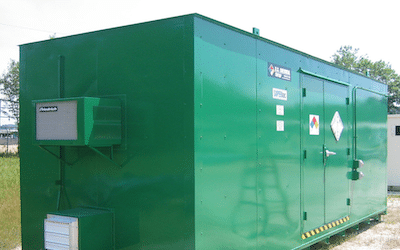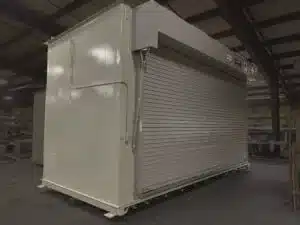Expert Tips from U.S. Chemical Storage for Safe Ethanol Storage

Updated 5/29/24
The NFPA classifies ethanol as a Class IB flammable liquid. Therefore, this chemical should be handled and stored with great care. Ethanol chemical storage buildings are a key part of this chemical’s day-to-day use and preservation.
 Ethanol usage as a biofuel additive has grown rapidly since the early 2000s. Trains transport large volumes of it across the country, but ethanol remains a transportation hazard.
Some of the biggest safety and environmental incidents involving ethanol have occurred on the railways. Other notable incidents include explosions and fires at distilleries in their storage facilities.
Unlike oil fires, ethanol fires do not produce thick black smoke. Firefighters call them “invisible fires.” The heat zone reaches far beyond the visible flames. These fires are very difficult to extinguish. In derailment incidents, they are generally allowed to burn out.
Ethanol usage as a biofuel additive has grown rapidly since the early 2000s. Trains transport large volumes of it across the country, but ethanol remains a transportation hazard.
Some of the biggest safety and environmental incidents involving ethanol have occurred on the railways. Other notable incidents include explosions and fires at distilleries in their storage facilities.
Unlike oil fires, ethanol fires do not produce thick black smoke. Firefighters call them “invisible fires.” The heat zone reaches far beyond the visible flames. These fires are very difficult to extinguish. In derailment incidents, they are generally allowed to burn out.
 U.S. Chemical Storage supplies fire-rated and non-fire-rated chemical storage buildings. All prefabricated buildings feature built-in secondary containment sumps. Continuously welded steel sheets give the sump its strength and leak-tight performance.
RELATED ARTICLE: The Importance of Spill Containment Sumps in Chemical Storage Buildings
The U.S. Chemical Storage buildings offer optional accessories ideal for bulk ethanol storage. Climate control systems regulate the temperature within the specific range required for ethanol and prevent excessive condensation buildup.
Use exhaust fans to remove flammable vapors. Automatic dry chemical or water sprinkler fire suppression systems limit the spread of fires. This is vital since the fuel must burn out in ethanol fires. All electrical equipment included in ethanol storage buildings is intrinsically safe to prevent sparks.
U.S. Chemical Storage supplies fire-rated and non-fire-rated chemical storage buildings. All prefabricated buildings feature built-in secondary containment sumps. Continuously welded steel sheets give the sump its strength and leak-tight performance.
RELATED ARTICLE: The Importance of Spill Containment Sumps in Chemical Storage Buildings
The U.S. Chemical Storage buildings offer optional accessories ideal for bulk ethanol storage. Climate control systems regulate the temperature within the specific range required for ethanol and prevent excessive condensation buildup.
Use exhaust fans to remove flammable vapors. Automatic dry chemical or water sprinkler fire suppression systems limit the spread of fires. This is vital since the fuel must burn out in ethanol fires. All electrical equipment included in ethanol storage buildings is intrinsically safe to prevent sparks.
 Ethanol usage as a biofuel additive has grown rapidly since the early 2000s. Trains transport large volumes of it across the country, but ethanol remains a transportation hazard.
Some of the biggest safety and environmental incidents involving ethanol have occurred on the railways. Other notable incidents include explosions and fires at distilleries in their storage facilities.
Unlike oil fires, ethanol fires do not produce thick black smoke. Firefighters call them “invisible fires.” The heat zone reaches far beyond the visible flames. These fires are very difficult to extinguish. In derailment incidents, they are generally allowed to burn out.
Ethanol usage as a biofuel additive has grown rapidly since the early 2000s. Trains transport large volumes of it across the country, but ethanol remains a transportation hazard.
Some of the biggest safety and environmental incidents involving ethanol have occurred on the railways. Other notable incidents include explosions and fires at distilleries in their storage facilities.
Unlike oil fires, ethanol fires do not produce thick black smoke. Firefighters call them “invisible fires.” The heat zone reaches far beyond the visible flames. These fires are very difficult to extinguish. In derailment incidents, they are generally allowed to burn out.
What is Ethanol Used For?
Ethanol is a clear and colorless liquid with many commercial and industrial applications. The pharmaceutical industry uses ethanol as a solvent and preservative in the manufacturing of drugs. It is also the primary ingredient in microbrewery alcoholic beverages. Other uses include the manufacturing of scents, flavorings, and product coloring. As mentioned above, ethanol is also used as a biofuel additive for gasoline. The United States is the largest producer of ethanol fuel in the world. Typical gasoline blends may contain up to 10 percent ethanol. This percentage is trending up – 15 percent blends are becoming more commonplace.How is Ethanol Made?
Ethanol, also known as ethyl alcohol, is produced primarily through fermentation or chemical synthesis. In fermentation, raw materials such as grains, fruits, or sugarcane are crushed and mixed with water to form a mash. Yeast then ferments the sugars in the mash into ethanol and carbon dioxide. The resulting mixture, known as beer, undergoes distillation to separate ethanol from water and other impurities. In chemical synthesis, ethylene gas, derived from petroleum or natural gas, is hydrated in the presence of a catalyst. This hydration reaction converts ethylene into ethanol by reacting it with steam. The crude ethanol obtained from this process undergoes purification to remove impurities.Adhere to Ethanol Storage Regulations
Adhering to ethanol storage regulations is essential to ensuring safety, environmental protection, and legal compliance within your facility, including:1. Building Codes and Standards
Comply with relevant building codes governing the construction and design of ethanol storage facilities. This includes using fire-resistant materials, installing appropriate ventilation systems, and implementing effective containment measures, like the buildings U.S. Chemical storage builds.2. Storage Tank Compliance
Ensure all ethanol storage tanks meet regulatory requirements for design, construction, and maintenance. Tanks must have proper corrosion protection and secondary containment systems and undergo testing to prevent leaks or spills.3. Labeling and Documentation
Clearly label all ethanol storage tanks and containers with essential information, including contents, hazards, and emergency procedures. Maintain accurate documentation of ethanol inventory, safety inspections, and Material Safety Data Sheets (MSDS) for regulatory compliance.4. Fire Safety Measures
Install appropriate fire suppression systems, such as sprinklers or foam suppression systems, to mitigate fire hazards associated with ethanol storage. Conduct fire risk assessments, develop emergency shutdown procedures, and provide personnel training in fire prevention and response to enhance safety measures.5. Environmental Compliance
Adhere to environmental regulations governing air emissions, wastewater management, and hazardous waste disposal to minimize the environmental impact.List of Standards for Ethanol Storage
- 29 CFR OSHA 1910.106 – Flammable Liquids
- NFPA 30 – Flammable and Combustible Liquids Code
Follow Ethanol Temperature and Labeling Requirements
When storing ethanol, adhering to specific temperature conditions and labeling requirements is crucial to ensure safety, compliance, and effective management.Temperature Requirements
Ethanol should be stored within a temperature range recommended by regulatory guidelines. Ethanol has specific storage requirements due to its properties and associated hazards. Pure ethanol has a flashpoint of 55 F (13 C). It releases vapors into the atmosphere, creating a flammable environment. Temperature-controlled chemical storage buildings will prevent excess evaporation.Labeling Requirements
Ethanol storage tanks and containers must be labeled clearly to provide essential information for safe handling and emergency response. Labels should include the following information:- The words “Ethanol” or “Ethyl Alcohol” are prominently displayed to indicate the contents.
- Hazard warnings and symbols in accordance with regulatory standards, indicating flammability and health hazards.
- Safety precautions and handling instructions, including measures to prevent ignition sources and avoid contact with skin or eyes.
- Emergency contact information for reporting spills, leaks, or accidents.
Safely Store Ethanol with U.S. Chemical Storage
Ethanol tends to absorb water from the surrounding environment, so store it in dry areas with low humidity. Ethanol will absorb any condensation that forms inside storage vessels. OSHA sets requirements for the storage of flammable liquids. The closer the storage area is to an occupied building, the more stringent the regulations. For instance, a 4-hour fire-rated building must be used if you are storing ethanol at a distance of 10 feet or less from an occupied building. Use a 2-hour fire-rated building when storing anywhere from 10 feet up to 30 feet away. Use non-fire-rated chemical storage buildings when located 30 feet away or more from an occupied building. RELATED ARTICLE: Why Chemical Storage Buildings Need Climate Control U.S. Chemical Storage supplies fire-rated and non-fire-rated chemical storage buildings. All prefabricated buildings feature built-in secondary containment sumps. Continuously welded steel sheets give the sump its strength and leak-tight performance.
RELATED ARTICLE: The Importance of Spill Containment Sumps in Chemical Storage Buildings
The U.S. Chemical Storage buildings offer optional accessories ideal for bulk ethanol storage. Climate control systems regulate the temperature within the specific range required for ethanol and prevent excessive condensation buildup.
Use exhaust fans to remove flammable vapors. Automatic dry chemical or water sprinkler fire suppression systems limit the spread of fires. This is vital since the fuel must burn out in ethanol fires. All electrical equipment included in ethanol storage buildings is intrinsically safe to prevent sparks.
U.S. Chemical Storage supplies fire-rated and non-fire-rated chemical storage buildings. All prefabricated buildings feature built-in secondary containment sumps. Continuously welded steel sheets give the sump its strength and leak-tight performance.
RELATED ARTICLE: The Importance of Spill Containment Sumps in Chemical Storage Buildings
The U.S. Chemical Storage buildings offer optional accessories ideal for bulk ethanol storage. Climate control systems regulate the temperature within the specific range required for ethanol and prevent excessive condensation buildup.
Use exhaust fans to remove flammable vapors. Automatic dry chemical or water sprinkler fire suppression systems limit the spread of fires. This is vital since the fuel must burn out in ethanol fires. All electrical equipment included in ethanol storage buildings is intrinsically safe to prevent sparks.
Contact U.S. Chemical Storage for Your Ethanol Storage Needs
U.S. Chemical Storage provides technical advice and custom solutions to help safely store ethanol. We ensure safety and compliance to code. Contact us to learn more about our storage solutions, get a complimentary quote, or browse our expansive range of chemical storage solutions.References
- Fire House. Ethanol Fuel Presents New Challenges to Firefighters
- PubChem. Ethanol
- Government Fleet. Storing, Dispensing & Using Ethanol-Gasoline Blends
